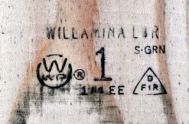When you go to the lumber yard, buy your lumber and then go to the yard to be loaded, (or do all of that yourself at the big box stores) how do you know you’re getting what you paid for? The grade stamp. Without the grade stamp, you’re at the mercy of the yardman to load “whatever” he wants. So it’s there for your protection.  But do you know what you’re looking at when you see that stamp on the next 2×4 your buy? Most people don’t. So I’m going to break it down for you.
But do you know what you’re looking at when you see that stamp on the next 2×4 your buy? Most people don’t. So I’m going to break it down for you.
Most of the framing lumber in the Kansas City lumber market are western species. That means, they come from the west coat, Canada, or Oregon, Washington, Idaho and Montana. So that is what I’m going to concentrate on here. We’ll save the southern species for the next article.
So here are the five things that you should find on your lumber:
a The WWPA certification mark which certifies association quality supervision.
b Mill ID. Usually a number which identifies the producing mill.
c The grade designation, name or number. (We’ll talked more about this later)
d Species. What kind of wood this is. Doug Fir, Hem-Fir, SPF, etc.
e Condition or the seasoning, or how was it dried at the mill at the time of surfacing.
The three you should be looking for are c, d, & e. The grade is the most important because that’s what you’re paying for. It can also be very confusing. The grades of dimensional lumber are based on either visual inspection or a combination of mechanical testing and visual inspection and are a judgment of end use strength rather than appearance. Natural log  characteristics that affect strength are taken into account along with manufacturing imperfections.
characteristics that affect strength are taken into account along with manufacturing imperfections.
There is a division within the grade. Select structural and light framing. Structural grades are select structural, 1, 2, 3, and light framing grades are construction (const), standard (stand), utility (util), stud. Select Structural are the highest grades in structural light framing and generally, the numbered grades are more expensive than the named grades. This is what you should be looking for when you need a floor joist or a rafter where strength and stiffness is required.
Select Structural (the grade) and MSR (Machine Stress Rated) is generally bought by the truss plants and is necessary for engineered wood trusses, so you won’t see it very often in the lumberyard. The most common grade in the structural category is #2 and better. Many times I have heard “I don’t want seconds, I want firsts”. Just because it says #2 does not mean it’s a “second”. In fact, #2 and better means the unit or bundle can actually contain up to 80% #1 in the unit. The same applies to standard and better, up to 80% construction grade. There is also a new wrinkle  caused by the “big box” stores. They want their lumber to be “pretty” in the store which means no wane (bark on the edges) minimal or no knots or any other appearance defects. Hence the new name “appearance grade”. Appearance grade does not mean it’s better, it just means it looks better. So just remember the old saying “looks can be deceiving” and look for the grade stamp.
caused by the “big box” stores. They want their lumber to be “pretty” in the store which means no wane (bark on the edges) minimal or no knots or any other appearance defects. Hence the new name “appearance grade”. Appearance grade does not mean it’s better, it just means it looks better. So just remember the old saying “looks can be deceiving” and look for the grade stamp.
Species is next. The Kansas City lumber market is primarily a green Douglas Fir market. This is what the builders prefer because of its high strength and relative ease of nailing. SPF (a combination of spruce-pine-fir species) would be the next most common species followed by Hem-Fir (Hemlock and Fir species) and Fir and Larch.
Last is moisture content. There is ALWAYS some moisture left in the wood. Most all of the Douglas Fir in the Kansas City Lumber market is S-GRN. That means it has a moisture content in excess of 19%, hence the name Green Doug Fir. S-DRY which is found commonly on other species means it has been dried to a moisture content of 19% or less.
My father and founder of Porters Building Centers always says, “if you don’t know lumber, know your lumberman”, which is really true. If you need lumber in the Kansas City, St. Joseph or Lake of the Ozarks areas, get to know Porters Building Centers!
Kent Porter
Porters Building Centers
